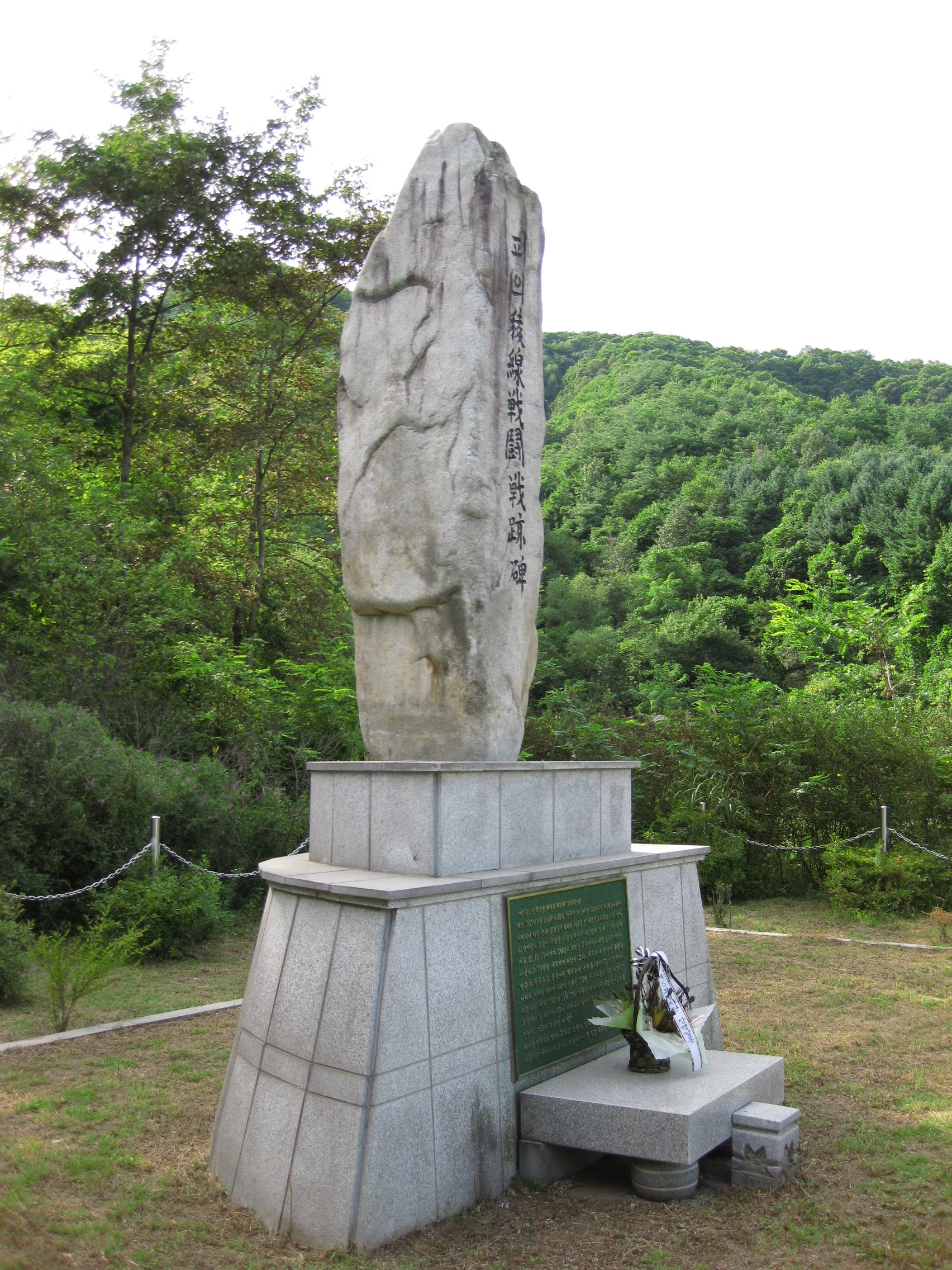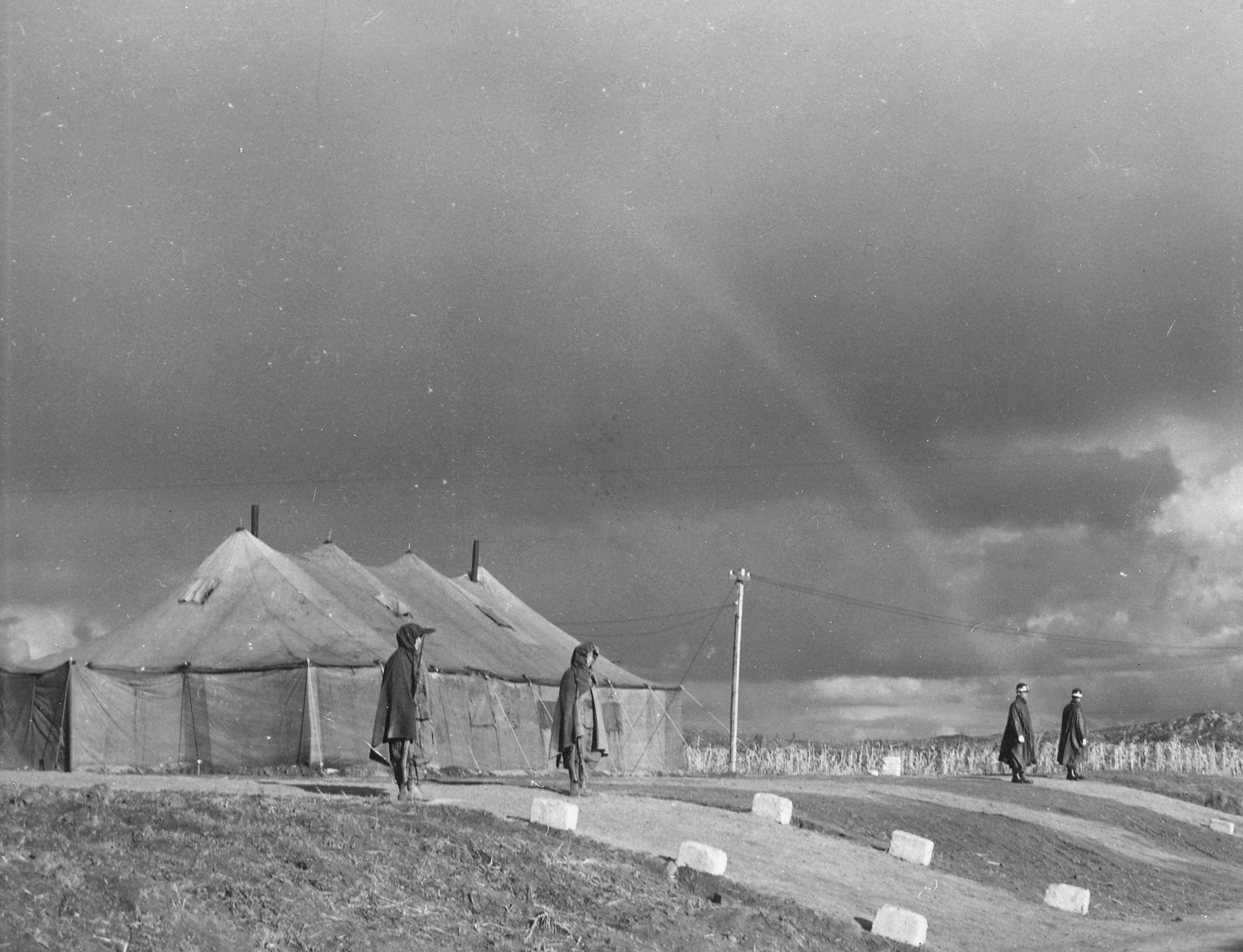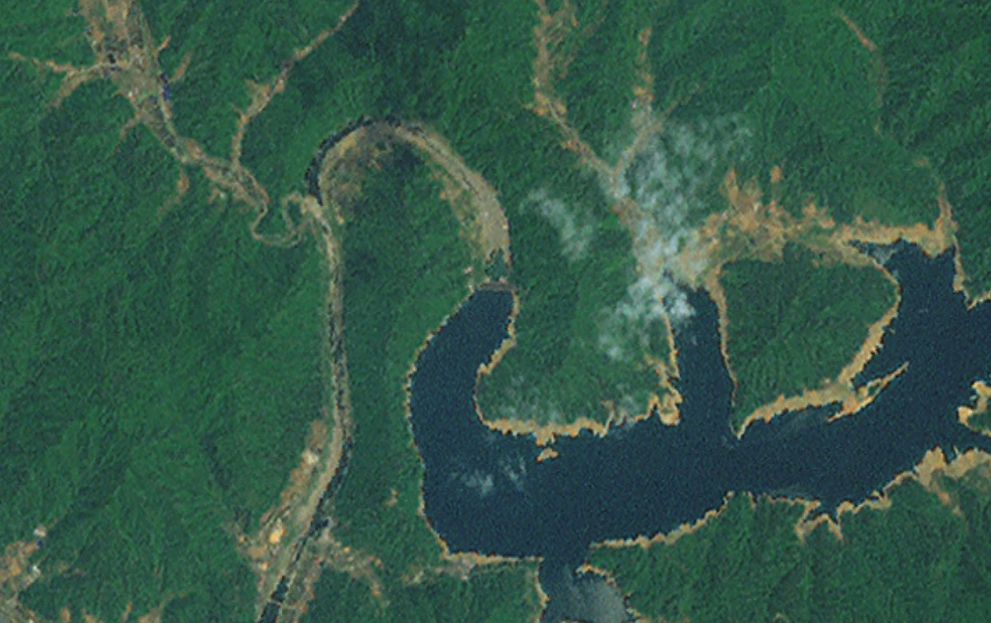|
Punchbowl (Korean War)
The Punchbowl ( ko, 펀치볼) was the name given to the bowl-shaped Haean Basin () in Yanggu County, Gangwon Province by UN Forces during the Korean War. The Punchbowl lies several km south of the Korean Demilitarized Zone. History The Punchbowl was captured by the Korean People's Army (KPA) in the opening days of the Korean War. It was recaptured by UN forces in late September 1950 during the UN offensive that followed the Inchon landings and the breakout from the Pusan perimeter. UN Forces abandoned the region in mid-December 1950, during the withdrawal following the Chinese People's Volunteer Army intervention in the war. On 4 June 1951 the 1st Marine Division and the ROK 5th Infantry Division began to advance north of Inje towards the Punchbowl and the Hwacheon Reservoir. By 10 June the Marine/ROKA force had secured Line Kansas northeast of the Hwacheon Reservoir and the southern line of hills overlooking the Punchbowl. Following the breakdown of armistice negoti ... [...More Info...] [...Related Items...] OR: [Wikipedia] [Google] [Baidu] |
Haean
Haean is a township ('' myeon'') in Yanggu County, Gangwon-do, South Korea. Haean sits in the distinctive Haean Basin (해안분지), which was nicknamed The Punchbowl by UN forces during the Korean War. The northern part of the basin lies within the Demilitarized Zone, and the area saw heavy fighting during the war. Geography The mountain Daeamsan (1304 m) is on the southern border of Haean Myeon. The central region of the basin is composed of Jurassic granite, with a pre-Cambrian metamorphic complex towards the edge. The basin may have been formed by differential weathering of the rock. Economy Farms within Haean produce potatoes, green vegetables, and lilies. History During the Koryo Dynasty Haean was known as Beonhwa (번화). It was renamed to Haean in 1885. Korean War As Haean lies north of the 38th parallel, it was controlled by North Korea before the start of the war. The North Korean army based artillery in the protection of the valley, making its capture ... [...More Info...] [...Related Items...] OR: [Wikipedia] [Google] [Baidu] |
1st Marine Division (United States)
The 1st Marine Division (1st MARDIV) is a Marine division of the United States Marine Corps headquartered at Marine Corps Base Camp Pendleton, California. It is the ground combat element of the I Marine Expeditionary Force (I MEF). It is the oldest and largest active duty division in the United States Marine Corps, representing a combat-ready force of more than 19,000 personnel. It is one of three active duty divisions in the Marine Corps today and is a multi-role, expeditionary ground combat force. It is nicknamed "The Old Breed". Mission The division is employed as the ground combat element (GCE) of the I Marine Expeditionary Force or may provide task-organized forces for assault operations and such operations as may be directed. The 1st Marine Division must be able to provide the ground amphibious forcible entry capability to the naval expeditionary force (NEF) and to conduct subsequent land operations in any operational environment.. Accessed 9 June 2009. 10 June 2009 ... [...More Info...] [...Related Items...] OR: [Wikipedia] [Google] [Baidu] |
Valleys Of South Korea
A valley is an elongated low area often running between Hill, hills or Mountain, mountains, which will typically contain a river or stream running from one end to the other. Most valleys are formed by erosion of the land surface by rivers or streams over a very long period. Some valleys are formed through erosion by glacier, glacial ice. These glaciers may remain present in valleys in high mountains or polar areas. At lower latitudes and altitudes, these glaciation, glacially formed valleys may have been created or enlarged during ice ages but now are ice-free and occupied by streams or rivers. In desert areas, valleys may be entirely dry or carry a watercourse only rarely. In karst, areas of limestone bedrock, dry valleys may also result from drainage now taking place cave, underground rather than at the surface. Rift valleys arise principally from tectonics, earth movements, rather than erosion. Many different types of valleys are described by geographers, using terms th ... [...More Info...] [...Related Items...] OR: [Wikipedia] [Google] [Baidu] |
Basins Of Asia
Basin may refer to: Geography and geology * Depression (geology) ** Back-arc basin, a submarine feature associated with island arcs and subduction zones ** Debris basin, designed to prevent damage from debris flow ** Drainage basin (hydrology), a topographic region in which all water drains to a common area ** Endorheic basin, a closed topographic low area with no drainage outlet ** Impact basin, a large impact crater ** Retention basin, stormwater runoff to prevent flooding and downstream erosion which includes a permanent pool of water ** Detention basin, a man-made basin used to temporarily store surplus water from rivers. ** Sedimentary basin (sedimentology), a low and usually sinking region that is filled with sediments from adjacent higher areas ** Structural basin, rock strata formed by tectonic warping of previously flat-lying strata *** Oceanic basin, a structural basin covered by seawater *** Pull-apart basin, a section of crust separated by the action of two strike- ... [...More Info...] [...Related Items...] OR: [Wikipedia] [Google] [Baidu] |
Battle Of The Punchbowl
The Battle of the Punchbowl ( ko, 펀치볼 전투), was one of the last battles of the movement phase of the Korean War. Following the breakdown of armistice negotiations in August 1951, the United Nations Command (UN) decided to launch a limited offensive in the late summer/early autumn to shorten and straighten sections of their lines, acquire better defensive terrain, and deny the enemy key vantage points from which they could observe and target UN positions. The Battle of Bloody Ridge took place west of the Punchbowl from August–September 1951 and this was followed by the Battle of Heartbreak Ridge northwest of the Punchbowl from September–October 1951. At the end of the UN offensive in October 1951, UN forces controlled the line of hills north of the Punchbowl. Prelude The Chinese People's Volunteer Army (PVA) Spring Offensive was stopped by 20 May 1951 and UN forces counterattacked forcing the PVA back to ''Line Kansas'' along the southern edge of the Punchbowl by 2 ... [...More Info...] [...Related Items...] OR: [Wikipedia] [Google] [Baidu] |
Republic Of Korea Marine Corps
The Republic of Korea Marine Corps (ROKMC; ko, 대한민국 해병대, Daehanminguk Haebyeongdae), also known as the ROK Marine Corps or ROK Marines, is the marine corps of South Korea. The ROKMC is a branch of the Republic of Korea Navy responsible for amphibious operations, and also functions as a rapid reaction force and a strategic reserve. The ROKMC was founded as a suppression operations force against communist partisans in 1949, prior to the Korean War. The ROKMC also fought in combat during the Vietnam War. The ROK Marine Corps, with 29,000 personnel, is organized into two divisions and two separate brigades under the Headquarters ROK Marine Corps. The ROK Marine Corps has about 300 tracked vehicles including assault amphibious vehicles, main battle tanks, and self-propelled artillery. History Founding years On April 15, 1949, the Republic of Korea Marine Corps (ROKMC) was founded at Deoksan airfield in Jinhae with an initial strength of 380 men. Lieutenant Colonel ... [...More Info...] [...Related Items...] OR: [Wikipedia] [Google] [Baidu] |
Battle Of Heartbreak Ridge
The Battle of Heartbreak Ridge (; french: Bataille de Crèvecœur), also known as the Battle of Wendengli (), was a month-long battle in the Korean War which took place between September 13th and October 15th, 1951. After withdrawing from Bloody Ridge, the Korean People's Army (KPA) set up new positions just away on a long hill mass. If anything, the defenses were even more formidable here than on Bloody Ridge. The Battle of Heartbreak Ridge was one of several major engagements in the hills of North Korea a few miles north of the 38th Parallel (the pre-war boundary between North and South Korea), near Chorwon. For the Chinese, this battle is often confused with the Battle of Triangle Hill, which occurred a year later. Background During the battle of Bloody Ridge, U.S. Eighth Army commander General James Van Fleet had submitted an outline plan, called Talons, to United Nations commander General Matthew Ridgway envisioning an advance of to remove the sag in the Eighth ... [...More Info...] [...Related Items...] OR: [Wikipedia] [Google] [Baidu] |
Battle Of Bloody Ridge
The Battle of Bloody Ridge was a ground combat battle that took place during the Korean War from 18 August to 5 September 1951. By the summer of 1951, the Korean War had reached a stalemate as peace negotiations began at Kaesong. The opposing armies faced each other across a line which ran from east to west, through the middle of the Korean peninsula, located in hills a few miles north of the 38th Parallel in the central Korean mountain range. United Nations and the North Korean Korean People's Army (KPA) and Chinese People's Volunteer Army (PVA) forces jockeyed for position along this line, clashing in several relatively small but intense and bloody battles. Bloody Ridge began as an attempt by UN forces to seize a ridge of hills which they believed were being used as observation posts to call in artillery fire on a UN supply road. Background U.S. Eighth Army commander General James Van Fleet had directed U.S. X Corps commander Maj. Gen. Clovis E. Byers to eliminate important ... [...More Info...] [...Related Items...] OR: [Wikipedia] [Google] [Baidu] |
United Nations Command
United Nations Command (UNC or UN Command) is the multinational military force established to support the South Korea, Republic of Korea (South Korea) during and after the Korean War. It was the first international unified command in history, and the first attempt at collective security pursuant to the Charter of the United Nations. The UNC was established on 7 July 1950 following the UN Security Council's recognition of North Korea, North Korean aggression against South Korea. The motion passed because the Soviet Union, a close ally of North Korea and a member of the UN Security Council, was boycotting the UN at the time over its recognition of the Taiwan, Republic of China rather than the China, People's Republic of China. Member states of the United Nations, UN member states were called to provide assistance in repelling the North's invasion, with the UNC providing a cohesive command structure under which the disparate forces would operate. During the course of the war, 22 nat ... [...More Info...] [...Related Items...] OR: [Wikipedia] [Google] [Baidu] |
Korean Armistice Agreement
The Korean Armistice Agreement ( ko, 한국정전협정 / 조선정전협정; zh, t=韓國停戰協定 / 朝鮮停戰協定) is an armistice that brought about a complete cessation of hostilities of the Korean War. It was signed by United States Army Lieutenant General William Harrison Jr. and General Mark W. Clark representing the United Nations Command (UNC), North Korea leader Kim Il-sung and General Nam Il representing the Korean People's Army (KPA), and Peng Dehuai representing the Chinese People's Volunteer Army (PVA). The armistice was signed on 27 July 1953, and was designed to "ensure a complete cessation of hostilities and of all acts of armed force in Korea until a final peaceful settlement is achieved." During the 1954 Geneva Conference in Switzerland, Chinese Premier and foreign minister Chou En-lai suggested that a peace treaty should be implemented on the Korean peninsula. However, the US secretary of state, John Foster Dulles, did not accommodate this attemp ... [...More Info...] [...Related Items...] OR: [Wikipedia] [Google] [Baidu] |
Hwacheon Dam
Hwacheon Dam is a concrete gravity dam on the North Han (Pukhan) River in Hwacheon County, Gangwon-do Province, South Korea. The dam was completed in 1944 as a primary source of electricity in southern Korea. It was the focal point of a raid during the Korean War and also provides flood protection from North Korea's Imnam Dam upstream. Background The dam was constructed by the Japanese during their occupation of Korea in World War II. The Han River Hydroelectric Company began construction in July 1939 and the dam was complete in October 1944. Several months prior in May, the first generator of the power plant was operational, the second that October. The third generator was operational in 1957 and the last of the four generators was installed in 1968. Before the upstream Peace Dam was completed in 2005, the Hwacheon Dam served as the first line-of-defense for a collapse or excess discharge from the Imnam Dam in North Korea. Korean War raid At midnight 8 April 1951, North ... [...More Info...] [...Related Items...] OR: [Wikipedia] [Google] [Baidu] |
Inje County
Inje County (''Inje-gun'') is a county in Gangwon Province, South Korea. It has the lowest population density of any South Korean county. History Since the first inhabitants came to the Korean peninsula, there have been people living in Inje county. Surrounded by clear and clean rivers and streams and magnificent Soraksan. Inje is located in the mid-east of Gangwon-do, it was at first called Jeojokhyeon in the Goguryeo Kingdom, Heejaehyeon in the Silla Kingdom, Inje in the Goryeo Dynasty, Youngsohyeon and again later Inje in the Joseon Dynasty and finally raised to the status of Inje county in August 1896. Korean War The Republic of Korea Army ROK) 5th Infantry Division recaptured Inje town in Operation Rugged in April 1951 as the UN Forces advanced to the ''Kansas Line'', north of the 38th Parallel. Inje town was lost again to the Chinese People's Volunteer Army during the Fifth Phase Offensive in late April 1951 and was recaptured in the UN May-June 1951 counteroffensive. ... [...More Info...] [...Related Items...] OR: [Wikipedia] [Google] [Baidu] |



